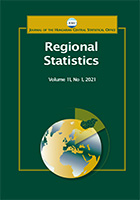Assessing regional quality of life with an integrated framework: An application to district of Kozhikode in the state of Kerala (India), 2011
Assessing regional quality of life with an integrated framework: An application to district of Kozhikode in the state of Kerala (India), 2011
Author(s): Fathima Zehba M. P., Mohammed Firoz C.Subject(s): Social Sciences, Economy, Geography, Regional studies
Published by: Központi Statisztikai Hivatal
Keywords: objective quality of life; development disparities; principal component analysis; spatial mapping; quality of life index; human development
Summary/Abstract: The effects of urbanisation in developing countries like India call for measuring regional disparities in Quality of Life (QOL). Though there exists, several internationally recognized indexes to assess QOL, a regional QOL assessment is yet not studied in India. The study attempts to develop such an assessment framework for measuring objective QOL at the regional level using a composite index, taking the case of Kozhikode, Kerala, India, as a case example. Firstly, a set of 19 variables under five domains of QOL was arrived at through several steps of screening processes, refinement from a master list, and a final expert opinion survey. Secondly, a Composite Quality of Life Index (CQOLI) was formulated by conducting a series of statistical analyses on the data set, including Principal Component Analysis (PCA). Thirdly, a spatial analysis of QOL of the study area was conducted by mapping the CQOLI scores to understand the pattern and analyse inequities. Accordingly, the spatial study units were grouped into High, Medium, and Low QOL. Out of the total settlements, it was found that 20% fell in high QOL, 46.25% in medium QOL, and 33.75% in low QOL. The pattern was spatially analysed based on the topographical divisions, namely lowlands, midlands, and highlands, and it was found that the QOL decreased from lowlands towards highlands. Finally, solutions and strategies which may be used as policy directives were proposed for each QOL group. The insights from the study are helpful for planners and decision-makers while implementing interventions in the study region. The methodology adopted here can be replicated in other regions of similar scale by altering the variables suited to the context.
Journal: Regional Statistics
- Issue Year: 14/2024
- Issue No: 01
- Page Range: 159-193
- Page Count: 35
- Language: English

